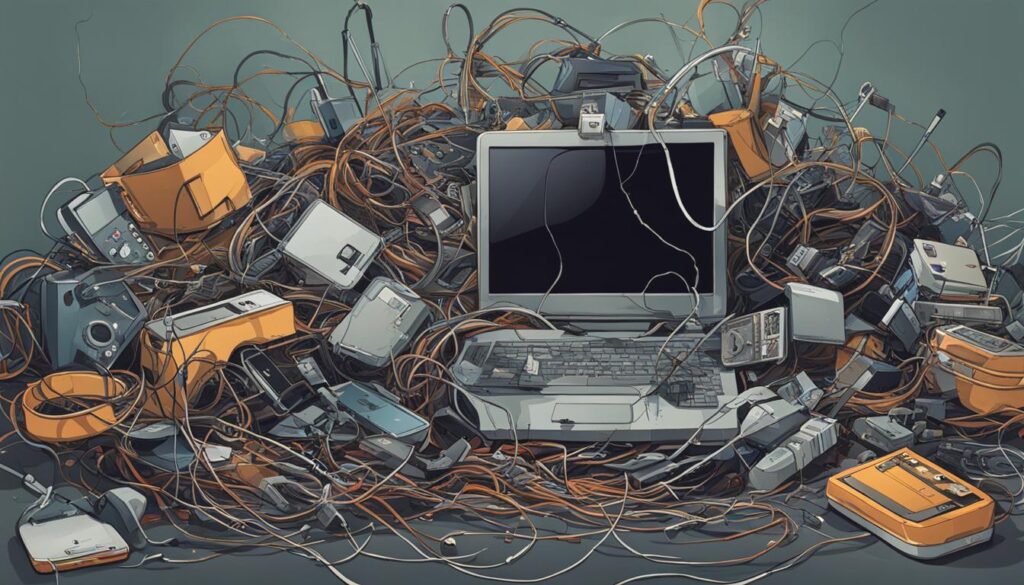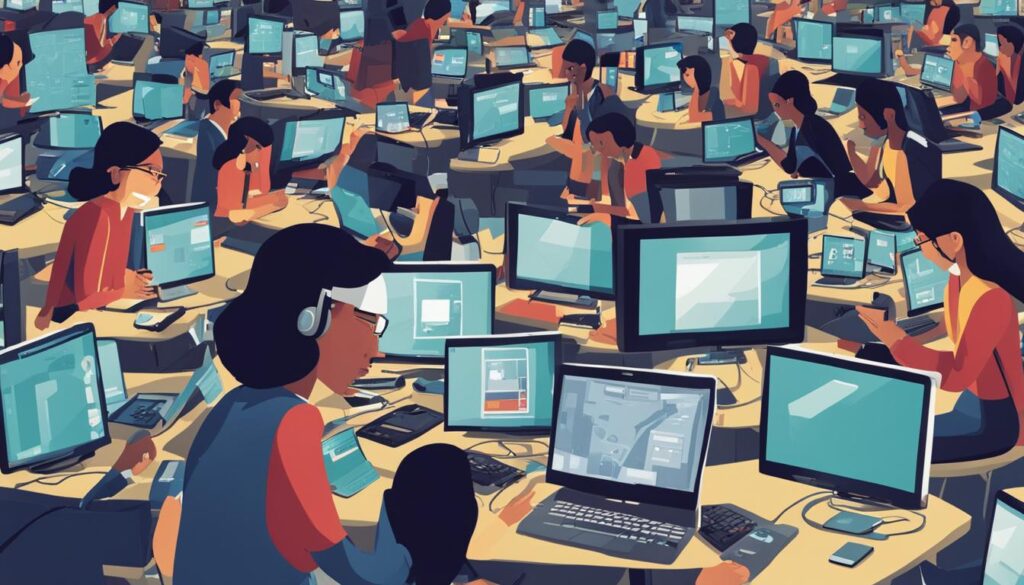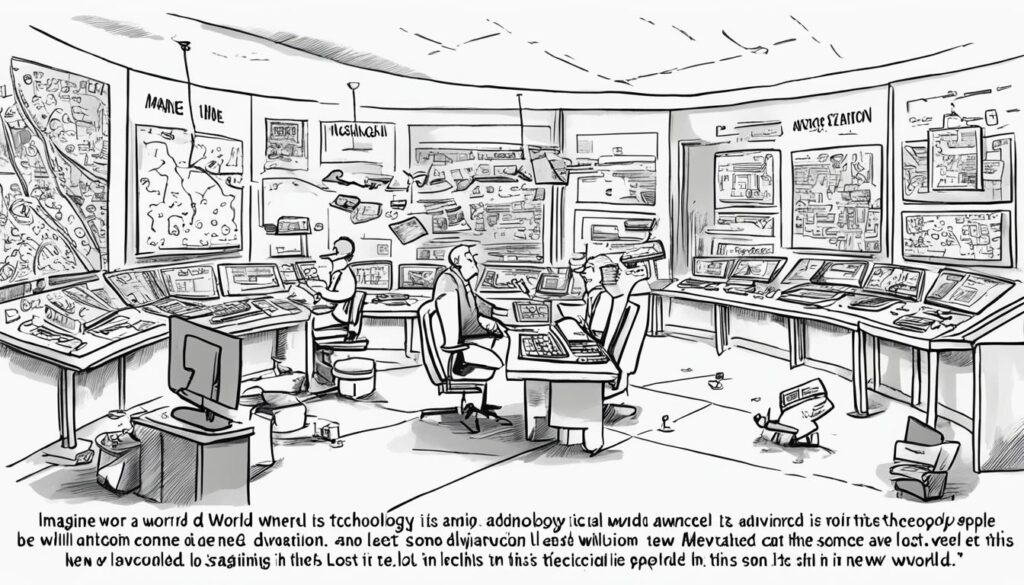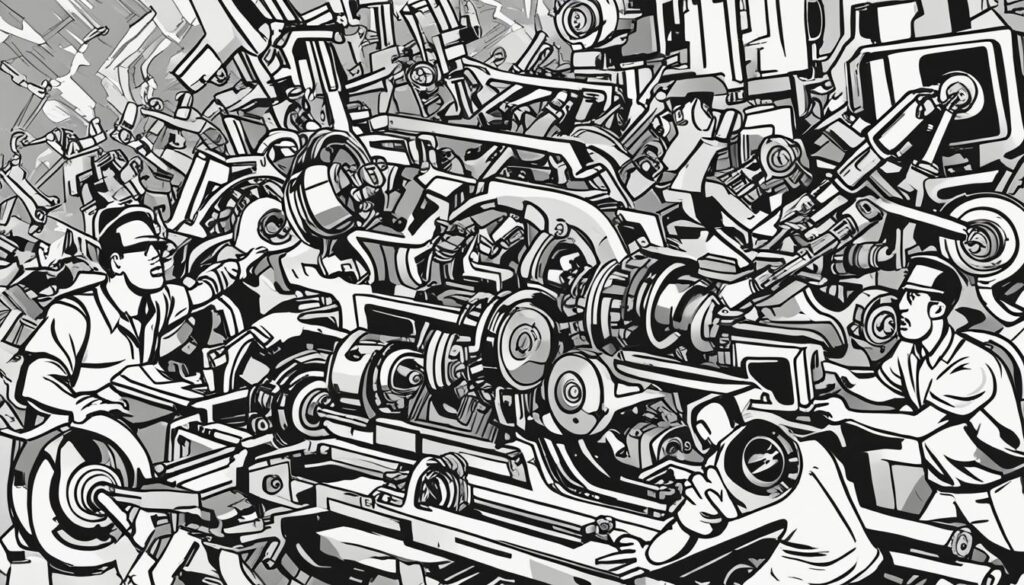I find solace in simplicity, where tangled cords and flashing screens leave me bewildered. Yes, I am technology challenged, a term that envelops the essence of my struggle. In a world driven by digital innovation, some call me technologically impaired or technologically inept. These words, like whispers of my inadequacy, carry the weight of a thousand gigabytes.
The Origin of the Term Luddite
Let me take you back to the early 19th century, a time when England was undergoing significant social and economic changes due to industrialization. It was during this period that the term Luddite entered the lexicon.
The Luddites were a group of workers who vehemently opposed the introduction of new machines, particularly in the textile industry. They feared that these machines would result in widespread unemployment and the loss of traditional jobs.
In their eyes, automation and mechanization would replace human labor, destabilizing their livelihoods. Fearing the impact of these changes, the Luddites resorted to destructive protests, sabotaging machinery as a form of resistance.
Today, the term Luddite has taken on a broader meaning. It is often used to describe individuals who resist or struggle with new technologies, including computers.
“The Luddites were the voice of a threatened working class who saw their way of life disappearing before their eyes, much like how some of us today struggle to keep up with the rapid pace of technological advancements.” – Anonymous
While the Luddites may not have been able to stop industrialization, their movement highlights the tensions that accompany the introduction of new technologies throughout history.
The Impact of Luddism
The Luddite protests had a lasting impact on public perception and discussions around the implications of industrialization. They drew attention to the potential negative consequences of unchecked technological progress and the need to consider the well-being of workers and communities amidst rapid change.
The Luddite Spirit
Although the Luddite movement may be regarded as a reaction to specific circumstances in the 19th century, its spirit lives on. Today, individuals who identify as Luddites or exhibit Luddite tendencies often express concerns about the negative impacts of new technologies on society, such as the erosion of privacy and the replacement of human labor.
| Key Points | Implications |
|---|---|
| The Luddites opposed the introduction of new machines during the industrial revolution. | Highlighting the potential negative consequences of technological advancements. |
| The term Luddite is now used to describe individuals who resist or struggle with new technologies. | Reflecting ongoing concerns about the impact of technology on society. |
Perspectives on Technology
As I dive deeper into the impact of technology on society, I encounter various perspectives that shed light on the complexities and nuances surrounding this topic. Some argue that technology leads to the dehumanization of work, depriving individuals of meaningful interactions and reducing them to mere cogs in a machine. The rise of automation and algorithms replacing human labor is seen as a threat, as it diminishes the value of human ingenuity and creativity.
On the other hand, there are those who believe that technology can be wielded as a tool for exploitation and oppression. They point to the way surveillance and targeted advertising have been used to manipulate vulnerable groups, perpetuating societal inequalities. These concerns raise questions about ethics and the role of technology in shaping our lives and values.
Technology has the power to shape the trajectory of society, but it is up to us to ensure it is used responsibly, without exacerbating existing power imbalances or eroding individual freedoms.
Another aspect of technology that warrants examination is its societal impact. The erosion of privacy and the concentration of power in the hands of a few tech giants are growing concerns. The collection and exploitation of personal data have raised alarms about the potential for abuse. As individuals, we must approach these issues with vigilance, demanding transparency and accountability from those who hold immense technological power.
However, it is important to acknowledge that technology has brought numerous benefits to society. It has revolutionized various industries, creating job opportunities and economic growth. Advances in public health, made possible through technological advancements, have improved the quality of life for many individuals.
The Duality of Technology
Ultimately, technology embodies a duality. It is both a tool of empowerment and a source of concern. Understanding this duality is essential as our society becomes increasingly reliant on technology. We must strike a balance between reaping the benefits of technological advancements and mitigating the risks they pose.
| Benefits of Technology | Concerns about Technology |
|---|---|
|
|
By embracing technology responsibly and proactively addressing its societal impact, we can navigate this digital era with greater confidence and ensure a future that upholds human dignity and equality.
The Modern Luddite
In the world of IT and new technology, there exist individuals who resist or oppose these advancements, often referred to as Luddites. These modern Luddites may have concerns about how technology threatens traditional ways of life and worry about the negative impacts it can have on society.
Unlike those who embrace the digital age with open arms, some individuals feel overwhelmed or intimidated by new technology. They prefer to stick to more familiar methods and find solace in the comforts of traditional ways.
It is important to understand and empathize with these individuals, rather than dismissing them as simply resistant to change. Each person has a unique relationship with technology, shaped by their experiences and beliefs.
“Technology is a double-edged sword. While it has the power to connect us, it can also disconnect us from the essence of what it means to be human.”
We must remember that technology is not inherently good or bad, but rather a tool that can shape our lives in both positive and negative ways. By acknowledging the concerns and fears of modern Luddites, we can foster a more inclusive and balanced approach to the integration of technology into our lives and society.
Status Quo vs. Technological Progress: Finding Common Ground
In a world where technological advancements are constantly reshaping the landscape, it is natural for some to resist the disruption that comes with it. Change can be unsettling, and it is important to acknowledge the valid concerns of those who question the impact of new technology.
However, it is also crucial to recognize the immense benefits that technology brings. From enhancing communication to revolutionizing industries, technology has the power to create opportunities and improve lives.
Instead of viewing the debate as a battle between the past and the future, we should strive to find common ground. By embracing technology while preserving the values and traditions that make us who we are, we can strike a harmonious balance between progress and heritage.
| Traditional Ways of Life | Negative Impacts of Technology |
|---|---|
| Inherent value in preserving cultural practices | Risk of job displacement due to automation |
| Connection to nature and the physical world | Privacy concerns in the digital age |
| Authentic human interactions | Potential for societal inequality |
In the midst of rapid technological advancements, we must navigate through the challenges while preserving the essence of what makes us human. It is by embracing the strides of IT and new technology while finding ways to honor our traditional ways of life that we can shape a future where progress and humanity coexist.
Benefits of Technology
In spite of the concerns raised about technology, it has bestowed upon society a myriad of benefits that cannot be overlooked. The advancements in information technology have led to the creation of exciting new industries and abundant job opportunities, revolutionizing the professional landscape for aspiring individuals.
Through technology, communication has been transformed, transcending geographical boundaries and enabling seamless collaboration between people. The world has become a smaller place, fostering connections and fostering creativity on a global scale.
And let us not forget the profound impact that technology has had on public health. It has become an indispensable tool, propelling the development of innovative medical treatments and facilitating the rapid dissemination of vital health information. Lives are being saved, and access to quality healthcare is no longer hindered by physical distance.
As technology continues to evolve, it opens doors to possibilities beyond our imagination. It is a catalyst for progress, opening new avenues and paving the way for a brighter future.
| Benefits of Technology | Description |
|---|---|
| New Industries | The rapid advancements in technology have created innovative industries and transformed existing ones, presenting exciting opportunities for growth and exploration. |
| Job Opportunities | Technology has generated an abundance of new professions, creating a demand for skilled individuals and fostering economic growth. |
| Communication | Technology has revolutionized the way we communicate, enabling instant connections and breaking down barriers of time and distance. |
| Public Health | Technology has played a pivotal role in advancing public health, from the development of life-saving treatments to the efficient dissemination of vital health information. |
Understanding Disruptive Innovation
Disruptive innovation, a concept introduced by Clayton M. Christensen, has revolutionized the world of business. This powerful theory provides valuable insights into how market entrants can succeed by targeting overlooked customer segments with innovative offerings and gradually challenging established leaders. By understanding the nuances of disruptive innovation, we can make informed strategic choices and stay ahead of industry trends.
| Key Points | |
|---|---|
| Theory by Clayton M. Christensen | Disruptive innovation |
| Success of market entrants | Targeting overlooked customers |
| Challenging established leaders | Gradual process |
| Common misconceptions | Misapplication of the term “disruptive” |
| Continual research and improvement | Evolving theory |
While the term “disruptive” is often misapplied, it is important to note that not all market newcomers can be classified as disruptors. Disruptive innovation theory has its limitations but continues to evolve and improve through ongoing research.
Misconceptions about Disruption
Disruption is often misunderstood as a sudden and dramatic event, shattering the status quo with immediate and irreversible consequences. However, in reality, disruption is a subtle and gradual process, silently transforming industries over time. It is like the gentle rustling of leaves before a storm, foretelling the winds of change.
Incumbents, entrenched in their positions of power, often fail to recognize disruption as an evolving phenomenon. They become complacent, failing to perceive the disruptive forces slowly creeping upon them. Blind to the potential threats, they remain entrenched in their traditional ways, unaware of the storm brewing on the horizon.
“Disrupt or be disrupted” has become a mantra, instilling fear in the hearts of incumbents. However, blindly accepting this notion can lead to misguided actions and the potential destruction of their core business. The pursuit of defending against disruptive competitors can make them lose sight of their true value and jeopardize the very essence of their existence.
To navigate the turbulent waters of disruption, a deep understanding of disruption theory is essential. It goes beyond recognizing disruption as a mere buzzword; it entails comprehending the intricate patterns and dynamics that drive disruptive innovation. It is only through this understanding that strategic choices can be made, empowering incumbents to adapt and thrive in the face of relentless disruption.
Common Misconceptions about Disruption
| Misconception | Reality |
|---|---|
| Disruption is sudden and dramatic. | Disruption is a gradual and evolving process. |
| Incumbents are invincible. | Incumbents can often ignore significant threats. |
| Blindly accepting “Disrupt or be disrupted” is the only path. | The pursuit of disruption can lead to core business jeopardization. |
| Disruption is only about new entrants. | Disruptive competition can arise from unexpected sources. |
The Utility of Disruption Theory
With its explanatory power and predictive abilities, disruption theory has emerged as a powerful tool for understanding and foreseeing industry evolution. Despite its limitations, this theory provides valuable insights into the dynamics of market entry, enabling businesses to identify potential threats and seize new opportunities.
As research progresses, we can anticipate further advancements in the explanatory and predictive capabilities of disruption theory. This evolving understanding will allow businesses to stay ahead of industry changes and make informed strategic decisions.
By embracing the principles of disruptive innovation, companies can navigate the tumultuous seas of industry evolution with confidence. Disruption theory equips organizations with the knowledge to adapt their strategies and capitalize on emerging trends, ensuring their relevance in a rapidly changing business landscape.
Rather than being caught off-guard by disruption, businesses armed with this theory can navigate new territories, anticipating shifts and proactively adjusting their course. The utility of disruption theory lies in its ability to shed light on industry dynamics, empowering businesses to shape their future.
“Disruption theory allows us to see beyond the surface ripples of change and dive deep into the undercurrents that shape industries. It’s like having a compass guiding us through uncharted waters, revealing hidden opportunities and alerting us to potential dangers.”
The image above visually represents the concept of industry evolution, symbolizing the transformative nature of disruption theory. Just as the currents of the ocean shape the landscape of the deep, disruption theory shapes the future of industries, navigating the challenges and uncovering the hidden treasures that lie beneath the surface.
Balancing Benefits and Challenges of Technology
Technology, with its wonders and possibilities, has become an integral part of our lives, revolutionizing the way we live, work, and connect with the world. The benefits of technology are undeniable, bringing us convenience, efficiency, and access to an abundance of information.
From advancements in healthcare that save lives to the emergence of new industries and job opportunities, technology has transformed society in profound ways. It has connected us on a global scale, enabling seamless communication and collaboration across borders. The digital transformation has ushered in an era of endless possibilities, opening up avenues for innovation and growth.
However, it is crucial to acknowledge the risks and challenges that come hand in hand with technology. As we delve deeper into the digital realm, issues such as privacy concerns and the potential for exploitation arise. The proliferation of data poses risks to our personal information, requiring us to be cautious and mindful of the digital footprint we leave behind.
Furthermore, cultural impact cannot be ignored when discussing the role of technology in society. While some embrace and seamlessly adopt new technologies, others may hesitate or struggle to integrate them into their lives and practices. Understanding cultural nuances is essential to ensure that technology serves as an enabler rather than a disruptor of traditions and values.
Source Links
- https://www.techtarget.com/whatis/definition/Luddite
- https://www.merriam-webster.com/dictionary/Luddite
- https://hbr.org/2015/12/what-is-disruptive-innovation













